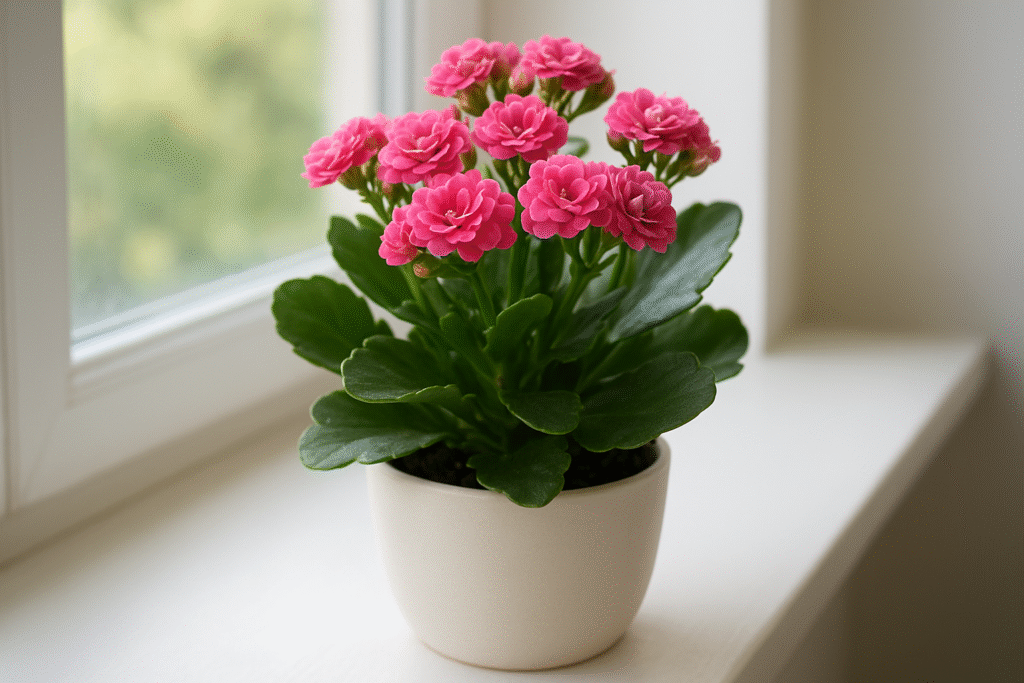The Calandiva plant is a stunning succulent that has become a favorite among indoor plant enthusiasts for its long-lasting and vibrant blooms. Belonging to the Kalanchoe family, this tropical beauty adds a burst of color to homes and offices alike. With minimal care needs, it’s perfect for both beginners and experienced plant lovers who want an easy yet eye-catching plant.
Native to Madagascar, the Calandiva plant is a hybrid of Kalanchoe blossfeldiana, bred for its double-layered flowers that resemble tiny roses. Available in shades of pink, red, yellow, orange, and white, it can bloom for several weeks, bringing life and color to any room.
Appearance and Key Features
The Calandiva plant is a compact, bushy succulent that typically grows up to 12 inches tall. Its thick, glossy leaves are deep green and store water, helping the plant survive in dry indoor conditions. The real highlight is its abundant clusters of small, rose-like flowers that can last up to six weeks.
Key Features:
- Long-lasting double blooms
- Thick, water-storing leaves
- Suitable for both indoor and outdoor pots
- Low maintenance and drought tolerant
- Ideal for gifting or home decoration
Light and Temperature Requirements
Calandiva loves bright, indirect sunlight. Place it near a sunny window where it can receive plenty of filtered light. Too much direct sunlight can scorch its leaves, while too little light can reduce flowering.
Best Conditions:
- Bright, indirect light for 6–8 hours a day
- Ideal temperature: 60°F to 85°F (15°C to 29°C)
- Protect from frost and cold drafts
If grown outdoors, make sure to bring the plant inside before temperatures drop too low.

Watering and Soil Tips
Like most succulents, the Calandiva plant doesn’t like to sit in water. Overwatering can lead to root rot, which is the most common cause of plant death.
Watering Tips:
- Allow the soil to dry out between waterings.
- Water deeply, but make sure excess water drains out.
- Reduce watering frequency during winter.
Soil Requirement:
Use a well-draining potting mix — cactus or succulent soil works perfectly. You can also mix regular potting soil with perlite or sand for extra drainage.
Fertilizing for Healthy Growth
Calandiva doesn’t require heavy feeding. A little fertilizer during the growing season (spring and summer) keeps the plant healthy and encourages blooms.
Fertilizing Tips:
- Use a balanced, water-soluble fertilizer every 4–6 weeks.
- Avoid over-fertilizing, as it may damage the roots.
- Stop feeding during fall and winter when the plant rests.
Pruning and Blooming Care
After the flowering season, prune away dead or faded blooms to encourage new growth. Light trimming also helps maintain the plant’s shape and prevents it from becoming leggy.
To promote blooming:
- Provide bright light daily.
- Avoid overwatering.
- Keep the plant in slightly cooler nighttime temperatures.
- Give it a short rest period after flowering before resuming regular care.
With the right conditions, Calandiva can bloom multiple times a year!
Common Problems and Solutions
Even though the Calandiva is easy to care for, it can face a few common issues if neglected.
1. Yellow Leaves: Usually a sign of overwatering. Let the soil dry completely before watering again.
2. Drooping or Soft Leaves: Caused by too much water or poor drainage. Ensure the pot has drainage holes.
3. No Flowers: Often due to insufficient light. Move your plant to a brighter spot.
4. Pests: Watch out for aphids or mealybugs. Wipe leaves with a mild soap solution or use neem oil spray.
Propagation Guide
Propagating the Calandiva plant is easy and rewarding. The best way is through leaf or stem cuttings.
Steps:
- Cut a healthy stem about 3–4 inches long.
- Let it dry for a day or two to form a callus.
- Plant it in well-draining soil.
- Water lightly and keep in bright, indirect light.
Within a few weeks, you’ll notice new roots forming. Once established, care for it like a mature Calandiva plant.
Benefits of the Calandiva Plant
Aside from its stunning looks, Calandiva offers several benefits:
- Air-purifying: Helps clean indoor air.
- Low maintenance: Perfect for busy lifestyles.
- Compact size: Ideal for small spaces, desks, or windowsills.
- Aesthetic appeal: Brings color and positivity to interiors.
It’s also known to symbolize endurance and lasting affection, making it a meaningful plant to gift.
Calandiva Plant Care Summary Table
| Aspect | Requirement |
|---|---|
| Light | Bright, indirect sunlight |
| Water | Moderate; let soil dry between waterings |
| Soil | Well-draining succulent mix |
| Temperature | 60°F–85°F (15°C–29°C) |
| Fertilizer | Every 4–6 weeks during growing season |
| Bloom Time | Mostly in spring and summer |
| Height | Up to 12 inches |

FAQs About Calandiva Plant
Q1: How often should I water my Calandiva plant?
Water only when the top inch of soil is dry. Overwatering can harm the roots.
Q2: Can Calandiva grow outdoors?
Yes, but only in warm climates. Protect it from frost and harsh sunlight.
Q3: Why is my Calandiva not flowering?
It may need more light or a rest period after blooming. Keep it in bright light and reduce watering after flowering.
Q4: Is Calandiva plant toxic to pets?
Yes, like other Kalanchoe varieties, it’s mildly toxic to cats and dogs if ingested. Keep it out of their reach.
Q5: How long do Calandiva flowers last?
Blooms can last 6–8 weeks with proper light and watering care.
Final Thoughts
The Calandiva plant is a delightful addition to any indoor garden. Its low-maintenance nature and stunning flowers make it a favorite among plant lovers. Whether you’re decorating your living space or gifting it to someone special, Calandiva brings color, life, and positivity wherever it grows.

